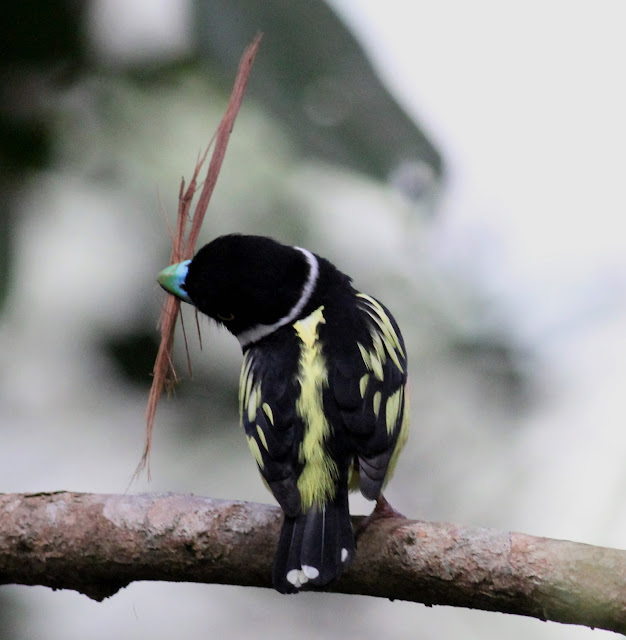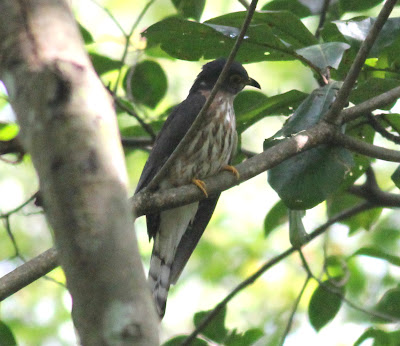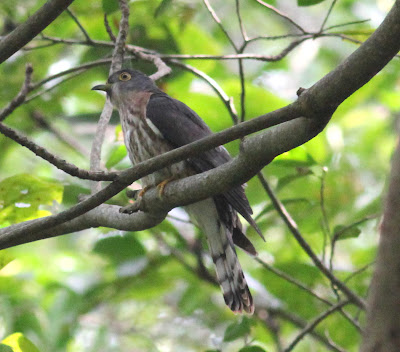The first bird seen was a Blyth's Hawk Eagle. Saw it as i was driving up. Look how close it flew near the road.
 |
| Pale Blue Flycatcher |
 |
| Black Eagle |
As i was climbing up, i saw this eagle circling above a tree top and trying to grab something.
Then i realised that the eagle was trying to catch these little stripped squirrels. There were plenty of them here.
No animal will move an inch once they see this eagle circling below the canopy but these little fellows (stripped squirrels) were faster and smarter - running down the tree trunks like crazy people.
Finally the eagle gave up and flew away. Although it may not be fully reported but a Penang birder (Chow Wai Mun) last saw this eagle here way back in 2009 (as per BiW records)
 |
| Black-Browed Barbet |
Its blue cheek gave away its id.
 |
| Siamang - adult |
Monkeys (in this case a gibbon) do have a pot belly as well.
 |
| Siamang - juvenile |
It was not walking but actually moving and dangling on the branch in a typical ape-style.
 |
| Orange-Breasted Trogon - male |
Perhaps one of the star birds here. Although it was quite near but it tried not to be too exposed in the open. Must thank the resident caretaker for searching this bird for me although we also dipped on a potential lifer (a flycatcher) which a group of Singaporean did saw it a day before. Nevertheless what is more important for me is that i have also managed to record this trogon's calls.
 |
| Buff-Rumped Woodpecker - male |
We saw two but only this male was seen trying to make a nest hole. His "wife" was probably watching him nearby.
According to the resident caretaker, he has seen spiderhunters got trapped in these webs and falconets will grab them from it.
 |
| Asian Brown Flycatcher |
 |
| Silver-Breasted Broadbill - female |
Perhaps the most common bird which you can find at this place.
Here is another common bird:
 |
| Black-and-yellow Broadbill |
This was the first time i have seen this broadbill here. The resident caretaker was equally delighted as he has not seen them making a nest at this place. It looks like the female is doing all the heavy workload in this case.
 |
| Red-Billed Malkoha |
 |
| Ashy Bulbul |
A White-Bellied Yuhina. Some books have named it as White-Bellied Erpornis.
 |
| Yellow-Bellied Warbler |
 |
| Grey-Rumped Treeswift-male |
There were also other swifts at this place. I believe the swifts below are Asian Palm Swifts
Dave Bakewell (2012) reported (in his blog) that what used to be one species has now been split into 3 i.e. i) Artic Warbler (P. borealis), ii) Kamchatka Leaf Warbler (P. examinandus) and iii) Japanese Leaf Warbler (P. xanthodryas). Well for time being i will just id this bird as an "Artic Warbler".
Other birds which we have seen and heard at this place are as follows:
i) Red-bearded Bee Eater (1) - heard calls only.
ii) Rhino Hornbill (2) - heard and seen.
iii) Scarlet Minivet (2) - heard and seen.
iv) Ochraceous Bulbul (5) - head and seen.
v) Stripped Throated Bulbul (1) - seen.
vi) Stripped-Tit Babbler (1) - seen.
vii) Streaked Spiderhunter (3) - heard and seen.
viii) Grey-breasted Spiderhunter (1) - heard and seen.
xi) Drongo Cuckoo (1) - perched
x) Unidentified Flycatcher (1)





















































